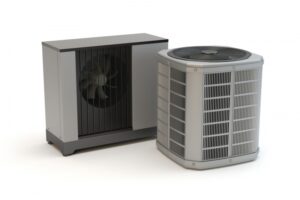When it comes to climate control in our homes, air conditioning systems have been a staple for decades. In recent years heat pumps have emerged as a versatile and energy-efficient alternative.
While both aim to keep our living spaces comfortable, understanding the unique components that set heat pumps apart from traditional AC units can help when it comes to heat pump repairs in Hamilton, OH. Understanding their differences can also shed light on their distinct advantages. Here are the essential parts that make a heat pump different from a conventional air conditioner.
The Heart of Heat Pump Versatility
The main differentiator between a heat pump and an AC system lies in the presence of an important part known as the reversing valve. This small but important device is the key to a heat pump’s ability to both cool and heat your home. In cooling mode the heat pump functions just like a traditional AC, extracting heat from indoor air and releasing it outside. When the seasons change and heating is required, the reversing valve shifts the flow of refrigerant. This allows the heat pump to absorb warmth from the outdoor air and transfer it indoors. A rather handy ability.
Suction Line Accumulator
Heat pumps, like air conditioners, circulate refrigerant to move heat. But in heating mode, heat pump uses less refrigerant. A device called the suction line accumulator handles the job of storing the unused refrigerant when the system switches into heating mode.
Dual-Purpose Efficiency
While both AC units and heat pumps have coils for heat exchange, the design and function of these coils in a heat pump are optimized for dual-purpose efficiency. In cooling mode the indoor coil acts as the evaporator that absorbs heat from the indoor air. In heating mode the roles reverse and the outdoor coil becomes the evaporator, extracting heat from the outdoor air. This unique adaptation allows heat pumps to efficiently provide heating and cooling functions using the same set of components.
Backup Heating for Chilly Days
One challenge heat pumps face is efficiency in extremely cold weather. To overcome this limitation, some are equipped with auxiliary heat strips. This is also known as electric resistance heating. When outdoor temperatures plummet and the heat pump struggles to extract sufficient warmth from the air, these strips kick in to provide an extra boost of heat. While this backup system helps to guarantee comfort even in colder climates, it’s important to note that it can be less energy-efficient than the primary system operation.
In the realm of home climate control heat pumps have carved out a niche by offering both heating and cooling functions in a single, energy-efficient package. The incorporation of a reversing valve, suction line accumulator, dual-purpose coils, and auxiliary heat strips distinguishes heat pumps from traditional AC units. By understanding these unique components you can make informed decisions about the most suitable climate control solution for your needs.

